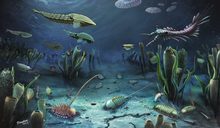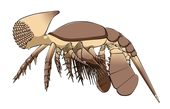A | B | C | D | E | F | G | H | CH | I | J | K | L | M | N | O | P | Q | R | S | T | U | V | W | X | Y | Z | 0 | 1 | 2 | 3 | 4 | 5 | 6 | 7 | 8 | 9
The examples and perspective in this article deal primarily with the English-speaking world and do not represent a worldwide view of the subject. (December 2022) |
| Part of a series on |
| Paleontology |
|---|
 |
|
Paleontology Portal Category |

A Fossil-Lagerstätte (German: [ˈlaːɡɐˌʃtɛtə], from Lager 'storage, lair' Stätte 'place'; plural Lagerstätten) is a sedimentary deposit that exhibits extraordinary fossils with exceptional preservation—sometimes including preserved soft tissues. These formations may have resulted from carcass burial in an anoxic environment with minimal bacteria, thus delaying the decomposition of both gross and fine biological features until long after a durable impression was created in the surrounding matrix. Fossil-Lagerstätten span geological time from the Neoproterozoic era to the present.
Worldwide, some of the best examples of near-perfect fossilization are the Cambrian Maotianshan shales and Burgess Shale, the Ordovician Soom Shale, the Silurian Waukesha Biota, the Devonian Hunsrück Slates and Gogo Formation, the Carboniferous Mazon Creek, the Triassic Madygen Formation, the Jurassic Posidonia Shale and Solnhofen Limestone, the Cretaceous Yixian, Santana, & Agua Nueva formations and the Tanis Fossil Site, the Eocene Fur Formation, Green River Formation, Messel Formation & Monte Bolca, the Miocene Foulden Maar and Ashfall Fossil Beds, the Pliocene Gray Fossil Site, and the Pleistocene Naracoorte Caves & La Brea Tar Pits.
Types
Palaeontologists distinguish two kinds:[1][2]
- Konzentrat-Lagerstätten (concentration Lagerstätten) are deposits with a particular "concentration" of disarticulated organic hard parts, such as a bone bed. These Lagerstätten are less spectacular than the more famous Konservat-Lagerstätten. Their contents invariably display a large degree of time averaging, as the accumulation of bones in the absence of other sediment takes some time. Deposits with a high concentration of fossils that represent an in situ community, such as reefs or oyster beds, are not considered Lagerstätten.
- Konservat-Lagerstätten (conservation Lagerstätten) are deposits known for the exceptional preservation of fossilized organisms or traces. The individual taphonomy of the fossils varies with the sites. Conservation Lagerstätten are crucial in elucidating important moments in the history and evolution of life. For example, the Burgess Shale of British Columbia is associated with the Cambrian explosion, and the Solnhofen limestone with the earliest known bird, Archaeopteryx.


Preservation
Konservat-Lagerstätten preserve lightly sclerotized and soft-bodied organisms or traces of organisms that are not otherwise preserved in the usual shelly and bony fossil record; thus, they offer more complete records of ancient biodiversity and behavior and enable some reconstruction of the palaeoecology of ancient aquatic communities. In 1986, Simon Conway Morris calculated only about 14% of genera in the Burgess Shale had possessed biomineralized tissues in life. The affinities of the shelly elements of conodonts were mysterious until the associated soft tissues were discovered near Edinburgh, Scotland, in the Granton Lower Oil Shale of the Carboniferous.[3] Information from the broader range of organisms found in Lagerstätten have contributed to recent phylogenetic reconstructions of some major metazoan groups. Lagerstätten seem to be temporally autocorrelated, perhaps because global environmental factors such as climate might affect their deposition.[4]
A number of taphonomic pathways may produce Konservat-Lagerstätten:[5]
- Phosphatization (replacing soft tissues with phosphate, such as Orsten-type and Doushantuo-type preservations).
- Silicification (replacing or entombing soft tissues with silica, such as petrified wood or Bitter Springs-type preservation).
- Kerogenization (soft tissues converted into inert carbonaceous films, as found in Burgess Shale-type preservation).
- Aluminosilification (replacing or coating soft tissues with films of aluminosilicate minerals).
- Pyritization (replacing soft tissues with pyrite, such as the exquisite detail found in Beecher's trilobite-type preservation).
- Calcification (replacing or soft tissues with calcite minerals).
- Siderite or calcite nodules (chemicals released by decaying soft tissue modify the surrounding sediment into a siderite concretion or coal ball encasing the fossil, as found in the Mazon Creek fossil beds).
- Rapid sediment cementation (impressions of soft tissue preserved through casts and molds in the surrounding sediment, such as Ediacaran-type preservation facilitated by microbial mats).
- Amber (soft tissues encased in hardened tree resin).
The identification of a fossil site as a Konservat-Lagerstätte may be based on a number of different factors which constitute "exceptional preservation". These may include the completeness of specimens, soft tissue preservation, fine-scale detail, taxonomic richness, distinctive taphonomic pathways (often multiple at the same site), the extent of the fossil layer in time and space, and particular sediment facies encouraging preservation.[5]
Notable Lagerstätten
The world's major Lagerstätten include:
Precambrian
| Site(s) | Age | Location | Significance | Notable fossils/organisms |
|---|---|---|---|---|
| Nonesuch Formation | 1083-1070 Ma | Michigan, USA | An oxygenated Mesoproterozoic lake[6] containing exceptionally preserved limnic microbes.[7] | |
|
Lakhanda Lagerstätte |
1030-1000 Ma |
Uchur-Maya Depression, Russia |
A site preserving a Mesoproterozoic community dominated by anaerobic bacteria.[8] The lagerstätte contains evidence of trophic interactions from the Boring Billion.[9][10] | |
|
1000–850 Ma |
South Australia |
Preserved fossils include cyanobacteria microfossils. |
 | |
| Diabaig Formation | 994 ± 48 Ma[11] | Scotland | An estuarine environment preserving phosphatic microfossils, which represent some of the oldest known non-marine eukaryotes.[12] | |
| Dolores Creek Formation | 950 Ma | Yukon, Canada | An Early Tonian site containing pyritised macroalgal fossils.[13] | |
|
Chichkan Lagerstätte |
775 Ma |
Kazakhstan |
A site from the transition between the prokaryote-dominated biota of the Early Neoproterozoic and the eukaryote-dominated biota of the Late Neoproterozoic and Phanerozoic.[14] | |
|
600–555 Ma |
Guizhou Province, China |
Spans the poorly understood interval between the end of the Cryogenian period and the late Ediacaran Avalon explosion. |
 | |
| Portfjeld Formation | 570 Ma | North Greenland | A Middle Ediacaran biota from the continent of Laurentia exhibiting Doushantuo-type preservation.[15] | |
|
565 Ma |
Newfoundland, Canada |
This site contains one of the most diverse and well-preserved collections of Precambrian fossils. |
 | |
|
555 Ma |
South Australia |
The type location the Ediacaran period, and has preserved a significant amount of fossils from that time. |
 | |
| Shibantan Lagerstätte | 551-543 Ma | Hubei, China | A terminal Ediacaran fossil assemblage preserving life forms living just before the Proterozoic-Phanerozoic transition.[16] | |
| Gaojiashan Lagerstätte | 551-541 Ma | Shaanxi, China | A lagerstätte documenting tube growth patterns of Cloudina.[17] | |
| Jiucheng Member | 551-543 Ma | Yunnan, China | A latest Ediacaran macrofossil biota dominated by giant, unbranching thallophytes.[18] | |
|
Khatyspyt Lagerstätte |
544 Ma |
Yakutia, Russia |
A Late Ediacaran lagerstätte preserving an Avalon-type biota.[19] |
Cambrian
| Site(s) | Age | Location | Significance | Notable fossils/organisms |
|---|---|---|---|---|
| Zhangjiagou | Fortunian | Shaanxi, China | A lagerstätte from the earliest Cambrian notable for its fossils of cnidarians,[20] cycloneuralians,[21][22] and the basal ecdysozoan Saccorhytus coronarius.[23] |  |
|
Maotianshan Shales (Chengjiang) |
518 Ma |
Yunnan, China |
The preservation of an extremely diverse faunal assemblage renders the Maotianshan shale the world's most important for understanding the evolution of early multi-cellular life. |
 |
|
518 Ma |
Hubei, China |
This site is particularly notable due to both the large proportion of new taxa represented (approximately 53% of the specimens), and the notable volume of soft-body tissue preservation. |
 | |
|
523-518 Ma |
A site known for its fauna, and that they were most likely preserved by a death mask. It is a part of the larger Buen Formation, and has a fauna similar to the Maotianshan shales. |
 | ||
| Poleta Formation | 519-518 Ma | Nevada, USA | The middle member of the formation preserves the Indian Springs Lagerstätte, one of the oldest such sites from former Laurentia. This site preserves a diversity of mineralized organisms such as trilobites and brachiopods, but also non-mineralized remains such as sponges, algae, and soft-bodied arthropods.[24] |  |
|
Sinsk Algal Lens |
518 Ma |
One of the oldest known Cambrian lagerstätten. The fauna of this site is unique, as it seems that they were adapted to living in dysaerobic conditions.[25] |
 | |
|
513 Ma |
Noted soft tissue mineralization, most often of blocky apatite or fibrous calcium carbonate, including the oldest phosphatized muscle tissue. |
 | ||
|
513–501 Ma |
Guizhou, China |
The middle part of the Kaili Formation, the Oryctocephalus indicus Zone, contains a Burgess Shale-type lagerstätte with many well-preserved fossils known collectively as the Kaili Biota. |
 | |
|
Murero Lagerstätte |
511-503 Ma |
Spain |
Thanks to the paleontological content, mainly trilobites, fourteen biozones have been established, the most precise biozonation for this time interval in the world. It also records in detail the so-called Valdemiedes event, the mass extinction episode at the end of the Lower Cambrian.[26] |
 |
|
~510–500 Ma |
Central Wisconsin, US |
This site preserves some of the oldest evidence of multicellular life walking out of the ocean, and onto dry land (in the form of large mollusks and euthycarcinoid arthropods). Other notable fossils include stranded scyphozoans, and some of the oldest true crustaceans (in the form of phyllocarids). |
 | |
|
508 Ma |
British Columbia, Canada |
One of the most famous fossil localities in the world. It is famous for the exceptional preservation of the soft parts of its fossils. At 508 million years old (middle Cambrian), it is one of the earliest fossil beds containing soft-part imprints. |
 | |
|
507 Ma |
A site known for its abundant Cambrian trilobites and the preservation of Burgess Shale-type fossils. The type locality for this site is Spence Gulch in southeastern Idaho. |
 | ||
|
Linyi Lagerstätte |
504 Ma |
A lagerstätte recognised for its exceptional preservation of arthropod limbs, intestines, and eyes.[27] |
 | |
|
504 Ma |
Western Utah, US |
A world-famous locality known for its prolific agnostid and Elrathia kingii trilobite remains. Varied soft bodied organisms are also locally preserved, including Naraoia, Wiwaxia and Hallucigenia. |
 | |
|
502 Ma |
Western Utah, US |
A site known for its occasional preservation of soft-bodied tissue, and diverse assemblage. |
 | |
|
500 Ma |
Western Utah, US |
A site that is dominated by trilobites and brachiopods, but also comprising various soft-bodied organisms, such as Falcatamacaris. |
 | |
|
Kinnekulle Orsten and Alum Shale |
500 Ma |
The Orsten sites reveals the oldest well-documented benthic meiofauna in the fossil record. Fossils such as microfossils of arthropods like free-living pentastomids are known. Multiple "Orsten-type" lagerstätten are also known from other countries. |
 |
Ordovician
| Site(s) | Age | Location | Significance | Notable fossils/organisms |
|---|---|---|---|---|
|
about 485 Ma |
Draa Valley, Morocco |
Zdroj:https://en.wikipedia.org?pojem=Lagerstätte

